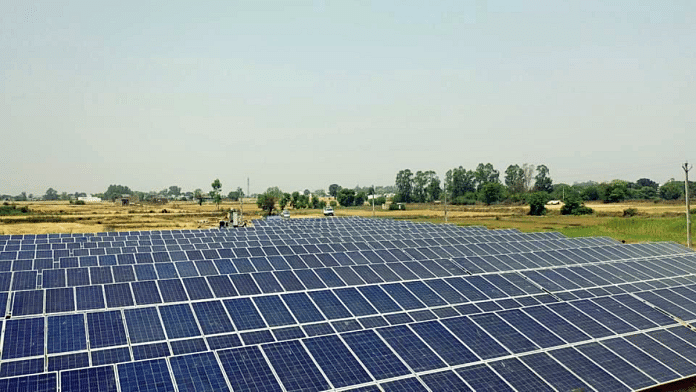New Delhi: Earlier this year, in Nagepur village of Uttar Pradesh’s Varanasi district, the Ministry of Panchayati Raj carried out a pilot project to identify rooftop spaces of buildings, especially residential, that can be used for installation of close to 15,000 solar panels.
This data, ministry officials said, could be used by the gram panchayats to develop solar infrastructure in the village.
The calculation for solar power was done based on the data collected by the ministry through the Survey of Villages and Mapping with Improvised Technology in Village Areas (SVAMITVA), which was launched in 2021. The scheme aims to prepare geo-referenced maps capturing digital images of properties in residential (abadi) areas of villages
The ministry is looking at the possibility of monetising the data collected under the SVAMITVA scheme for empowering villages in the future, ThePrint has learnt.
Similar pilots have been carried out in Chhattisgarh (Amora village in Balod district) and Maharashtra (Yerol village in Latur district) by the ministry to calculate the ‘solar energy production potential’ and provide examples to state governments on how such data can be monetised in the future for development of villages.
For the project, the ministry and National Informatics Centre (NIC) carried out digitisation of the built-up area (a process to identify the type of rooftop spaces) in the three villages.
“The NIC has classified the built-up area based on the SVAMITVA imageries as Reinforced Cement Concrete (RCC), tiled, tin sheds, etc., and calculated the area (of rooftops) where solar panels can be installed in these villages. The solar power generation has been calculated based on the solar energy calculation tool available on the Ministry of New and Renewable Energy’s website,” said a senior ministry official.
According to the calculation, in Nagepur village, there was space to install 14,913 500-watt solar panels on rooftops to generate 7.5 megawatts of solar power for six hours daily. Similarly, in Amora and Yerol villages, they found it would be possible to generate 6.3 and 3.5 megawatts for six hours daily, respectively, by installing solar panels, senior ministry officials told ThePrint.
“This information can be used in realising the solar power potential of our villages. It will be a win-win situation for panchayats and private solar panel companies and state governments,” said a ministry official.
The official added that like solar, other business opportunities can be explored if high-resolution, location-wise accurate data about the existing infrastructure in villages is made available.
“Leveraging the data, state governments can charge private companies for it in the future using the Swiss-challenge method. This will help villages by improving service delivery and will provide a good business opportunity for private firms,” the official said.
The Swiss-challenge method is a process of giving contracts under which a private firm or person can give a proposal, which is then put in the public domain for suggestion. If the proposal is accepted by the government, the firm which proposed it gets the right of first refusal.
Speaking to ThePrint, Sunil Kumar, former panchayati raj secretary, said, “Under SVAMITVA and other schemes a lot of village-level data (especially maps with information about existing infrastructure) is now available with the panchayati raj ministry.”
“This data could be obtained for commercial use and this will help in the development of villages. The central government needs to work out a policy for effectively using this data. The solar pilot project in three villages is an example of the commercial value of this data and how it can benefit the villages,” he added.
ThePrint reached the spokesperson at the Ministry of Panchayati Raj via WhatsApp message for a comment. This report will be updated if and when a response is received.
Also Read: How govt drone survey is clearing up land ownership in villages across India
Monetising data for solar power projects
In 2019, the ministry had launched Gram Manchitra, a Geographic Information System (GIS)-based spatial planning portal with granular details about infrastructure in villages across the country. It has countrywide information from 18 ministries/departments, such as on road networks, medical facilities, schools, mandis, etc.
Of the 3.53 lakh villages being covered under SVAMITVA in the country, 1:500 scale orthorectified images of over 37,000 villages have been uploaded on Gram Manchitra so far, according to the official.
“The ministry is now in the process of integrating the Gram Manchitra portal with geo-referenced maps prepared under the SVAMITVA scheme. This will improve the ability of the gram panchayats to plan interventions for the development of the villages more accurately,” said the official.
The data from Gram Manchitra and the SVAMITVA scheme is currently being used to monitor projects in villages under the central government’s Vibrant Village Programme.
The ministry officials said that the state governments or the panchayats can take the SVAMITVA data, get some value addition done, and provide it to private players. They can even charge for the data if they want, they added.
“The pilot project is just to show state governments how the data from SVAMITVA and Gram Manchitra can be used by making some value additions, such as giving more details about the built-up area for infrastructure projects and monetising it. The state governments can decide how they want to share or use the data,” said the official.
(Edited by Richa Mishra)
Also Read: Union govt works on scheme to help states, UTs streamline land & property records in urban areas



